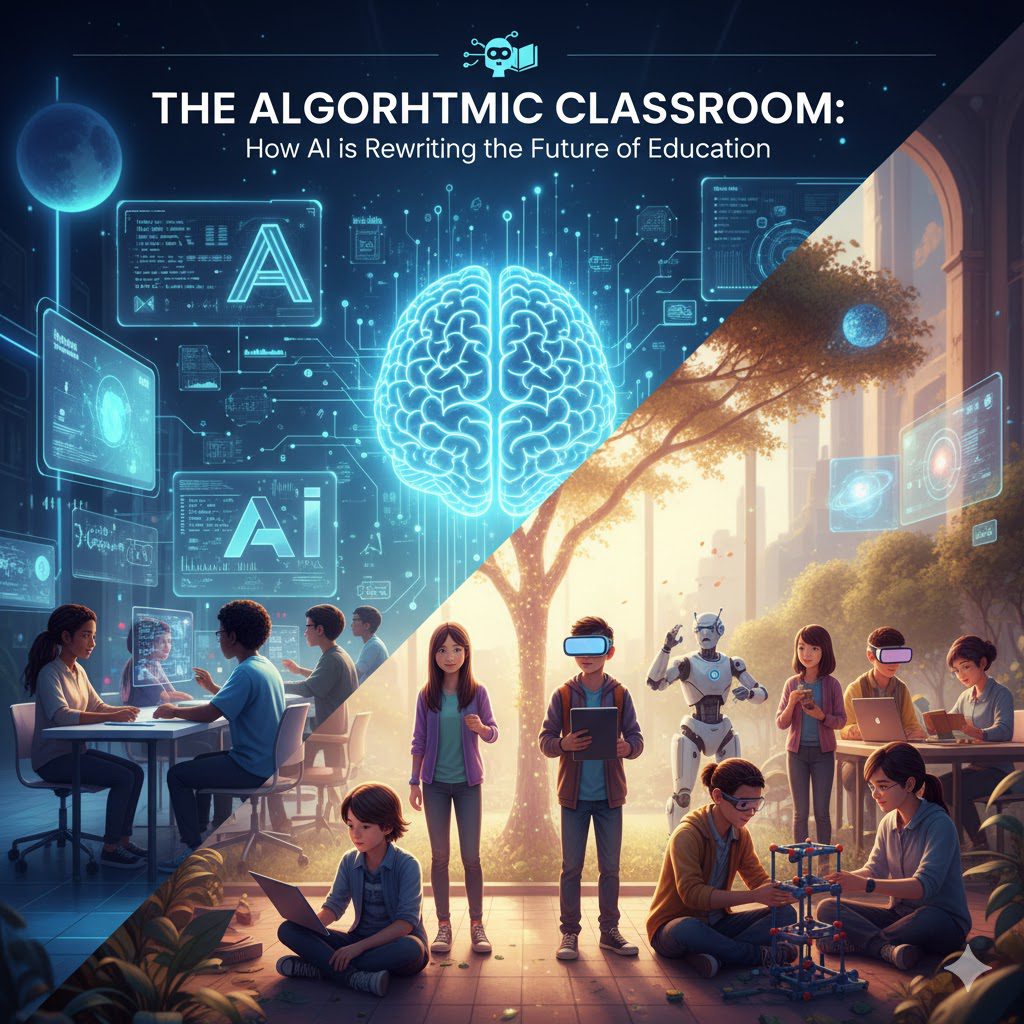Artificial intelligence has moved beyond theory to become a fundamental force in education. This deep dive explores how AI tools are personalizing learning, upgrading the role of teachers, and breaking down global barriers, while also examining the critical concerns of bias, privacy, and over-reliance on technology.
AI: From Buzzword to Foundational Tool
This period marks a definitive moment where artificial intelligence is no longer an experimental technology in the education sector—it is the very engine driving systemic change. AI has seamlessly integrated itself into the educational ecosystem, taking on roles that span the entire learning spectrum: the dedicated tutor, the tireless administrator, the dynamic lesson planner, and the hyper-personalized learning assistant. From refining lesson outlines to providing instantaneous essay feedback and even offering a degree of emotional support, powerful AI tools are fundamentally altering the methodology of teaching and the experience of learning.
Platforms like ChatGPT, Kamigo, and Google’s Classroom AI are at the forefront of this transformation. These tools are redefining the typical school day, posing profound questions: Does this future lead to truly equitable learning outcomes for every student? Is the gain in tailored instruction worth the potential loss of traditional human interaction and connection? To fully understand this seismic shift, we must examine the tangible impacts AI is having on students, educators, parents, and the long-term viability of modern education. The integration is not merely about digitizing old processes; it is about creating entirely new pathways for knowledge acquisition and pedagogical delivery, moving the focus from instruction delivery to personalized student mastery.
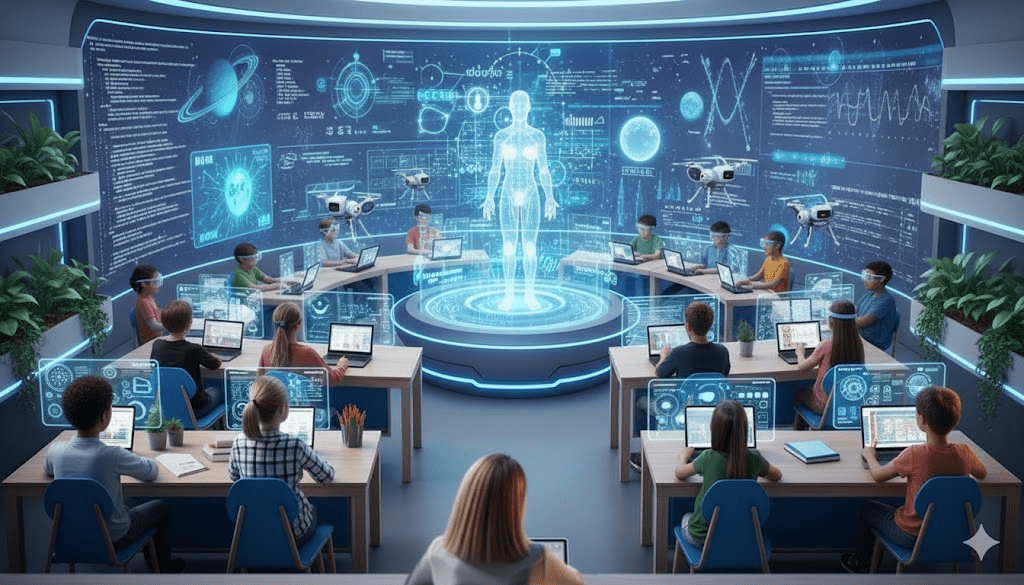
The ubiquity of smartphones and the general acceptance of advanced technology in daily life have paved the way for this educational revolution. AI applications are now seamlessly integrated into existing learning management systems (LMS), allowing schools to deploy these advanced features without overhauling their entire IT infrastructure. This ease of adoption has accelerated the pace of change, making AI-powered learning a reality for millions of students globally much faster than traditional educational reforms. The shift signifies a move from reactive teaching—where educators identify and correct deficiencies after they occur—to proactive, preventative education, where potential struggles are flagged by algorithms before they impede progress.
The Hyper-Personalized Learning Journey
The era of “one size fits all” education is definitively over. Thanks to machine learning, every student now navigates a unique learning journey tailored to their specific pace, knowledge gaps, and strengths. AI systems meticulously track individual student performance in real time. By analyzing every assignment score, quiz response, and time spent on a topic, the AI can instantly recommend supplemental learning materials, precisely identify areas of weakness, and offer alternative pathways to mastery.
Imagine a student grappling with complex fractions; the AI tutor immediately slows the pace, provides interactive examples, and perhaps reframes the concept using a real-world analogy. Conversely, a student who is demonstrating mastery in biology is instantly challenged with advanced concepts, allowing them to accelerate their learning and maintain engagement. This adaptive style of instruction is being pioneered by companies globally, such as Squirrel AI in China and Century Tech in the UK.
These platforms dissect learning into “micro-moments,” making constant, minute adjustments to the content to ensure the student is continuously challenged without ever being overwhelmed. The granular data collected by these systems allows them to distinguish between a lapse in attention and a genuine conceptual barrier, ensuring interventions are both timely and accurate. This level of detail was simply impossible for a single human teacher managing a classroom of thirty or more students.
Furthermore, this personalization extends crucial benefits to students with neurodiverse learning profiles and disabilities. AI technology is adept at converting speech to comprehensive notes, simplifying dense academic texts into digestible summaries, providing visual or auditory alternatives to complex lessons, and reading text aloud. This flexibility ensures that educational content is accessible and engaging for all learners, a significant step toward true educational inclusion.
For students on the autism spectrum, AI can help manage sensory input during online lessons or provide structured, predictable feedback that reduces anxiety. For students with dyslexia, AI platforms offer adjustable fonts, line spacing, and color overlays that have been scientifically proven to enhance readability. The core promise of AI in this context is to democratize accessibility, ensuring that a physical or cognitive difference is no longer a barrier to accessing high-quality education.
The AI-Powered Classroom and the Super Teacher
The vision of the AI classroom is not one where robots replace teachers, but where technology augments them into Super Teachers. AI integration directly into school portals, featuring tools like Microsoft Copilot for Education and Google’s advanced tutoring systems, means teachers are liberated from administrative overload. These systems respond to voice prompts, translate lesson notes for students from multilingual families, and generate custom quizzes instantly. The administrative burden, which has historically been a primary driver of teacher burnout and attrition, is now largely managed by intelligent automation.
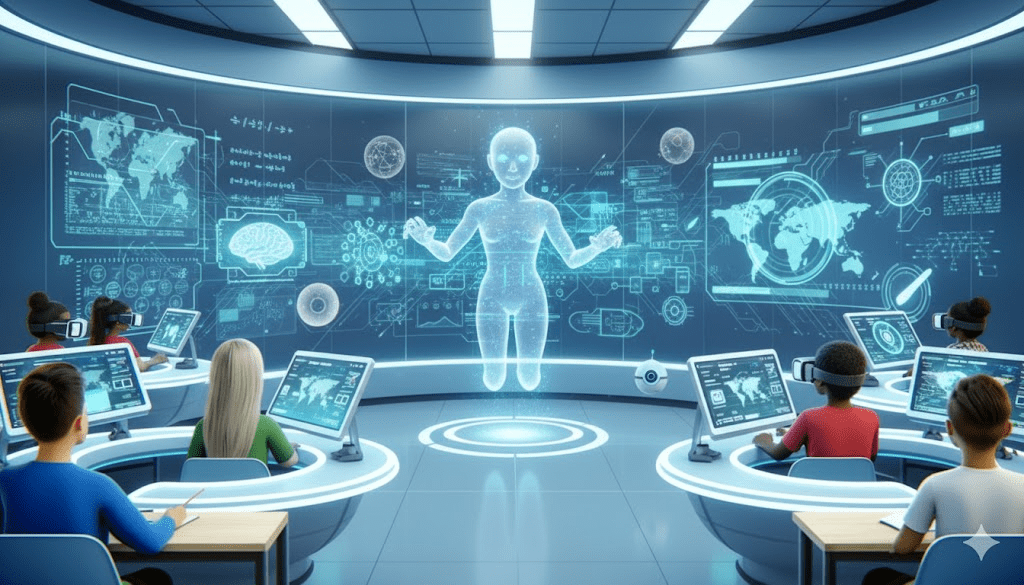
This allows educators to reclaim time that was historically monopolized by routine, repetitive tasks. With tools such as ScribeSense and GradeScope automating up to 80% of grading, teachers are saving crucial hours every single week. The newfound freedom allows them to dedicate more time to the aspects of their job that require human creativity, emotional support, and in-depth mentorship. They can now focus on fostering soft skills like collaboration, complex problem-solving, and emotional intelligence—areas where human interaction remains irreplaceable. The AI provides sophisticated data-driven insights, recommending optimal lesson plans based on real-time student data, analyzing past success rates of different teaching methods, and ensuring rigorous adherence to curriculum standards.
Educators are using AI to predict which students are at risk of falling behind, generate engaging digital content in seconds, and manage common parent or student inquiries using custom chatbots. The predictive power of AI allows for targeted, timely intervention, shifting the teacher’s role from diagnostician to personalized mentor. The ultimate result is a teaching profession with significantly less burnout and a dramatically increased capacity for high-impact instruction.
Anytime, Anywhere: 24/7 AI Tutors and Global Access
The days of waiting until the next class or office hours for help are obsolete. AI tutors are now available around the clock, offering tireless and frustration-free academic support. Students use applications like ChatUp Socratic and Brainly AI to immediately break down confusing instructions, get concepts explained in simpler language, practice conversational languages, draft essays, and solve complicated equations. This constant availability has demonstrably improved outcomes; for instance, a high school in California reported a significant 19% jump in math scores after the integration of AI tutoring into their curriculum. The barrier of a student feeling embarrassed or ashamed to ask a question in front of peers is eliminated, leading to more consistent and honest engagement with the material.
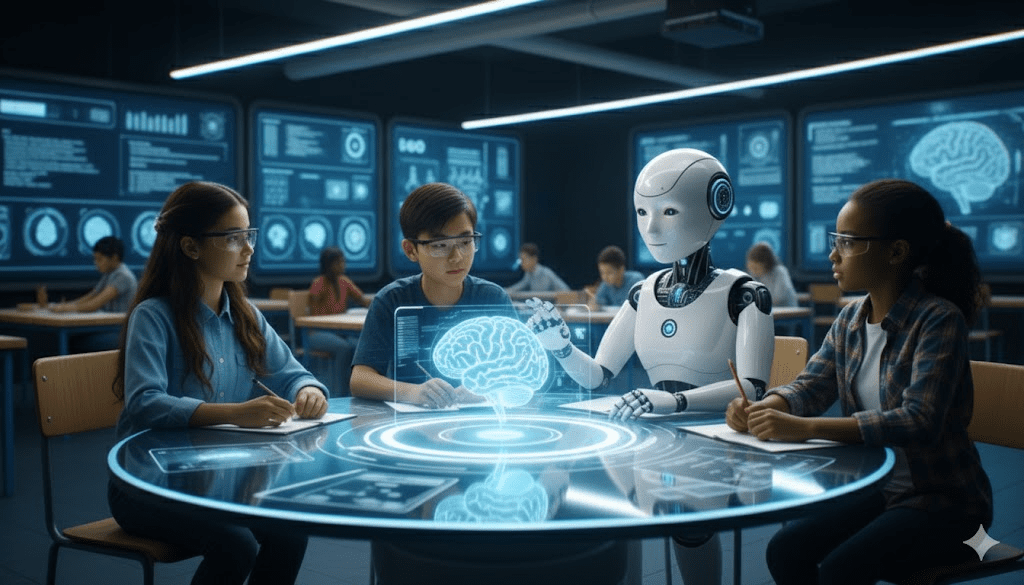
Beyond basic question-and-answer functionality, advanced AI tutors—such as Khan Academy’s AI tutor (which utilizes OpenAI technology)—are being trained to employ Socratic questioning. Instead of simply handing out answers, the AI prompts the student with deeper, guiding questions, pushing them toward critical thinking and genuine conceptual understanding. This methodology ensures that the student is actively constructing knowledge rather than passively receiving it, a cornerstone of effective learning theory.
This technological leap has a profound impact on global learning equity. AI is dissolving the historic barriers of geography and financial limitation. Real-time translation tools mean that students in rural regions of India can access and understand lectures from institutions like MIT.
In contexts such as refugee camps, AI-powered education platforms are providing personalized, structured schooling without the need for physical textbooks or classroom infrastructure. Language is rapidly transforming from a restrictive wall into an open window, with AI capable of translating, transcribing, and adapting complex educational content in real time across over 100 languages, creating a truly globalized, interconnected learning environment. The cost of distribution for high-quality educational content approaches zero, providing unprecedented access to world-class resources regardless of economic status.
Immersive Learning: Simulations and Virtual Realities
AI serves as the sophisticated cognitive engine that powers immersive learning experiences. The technology enables virtual reality (VR) and interactive simulations that were previously unattainable. For a biology class, a student can now don a VR headset and, guided by AI narration, virtually enter the human body to explore organ systems in three dimensions. In history, AI can reconstruct the Roman Forum or the Egyptian pyramids in highly detailed 3D models, allowing students to walk through and interact with ancient civilizations. This not only makes lessons more memorable but fundamentally changes the way students interact with abstract concepts, turning them into tangible, spatial experiences.
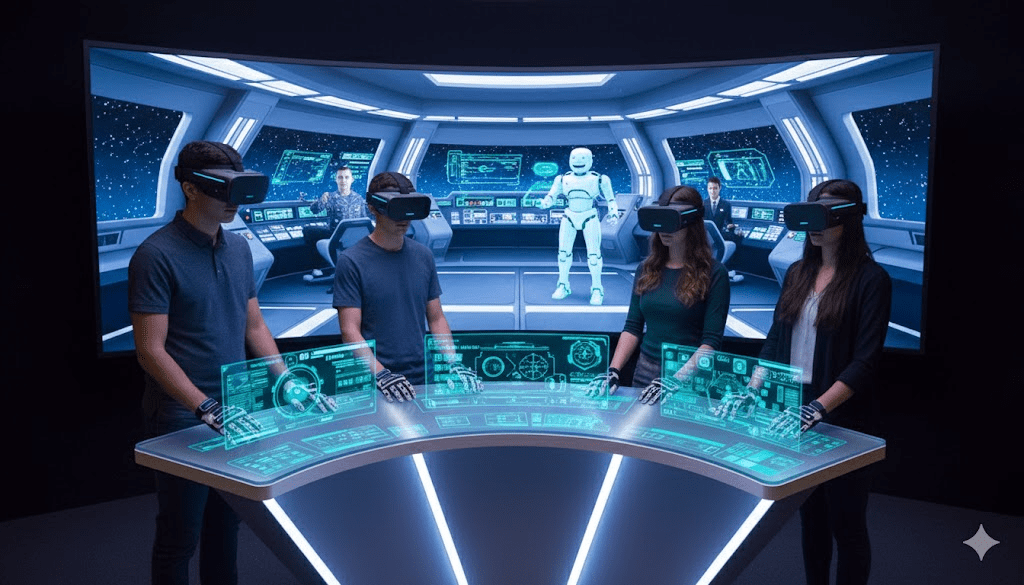
These simulations move education beyond passive consumption. They allow students to actively test scientific hypotheses, conduct elaborate and expensive experiments with zero risk or cost, and explore complex career paths from aerospace engineering to advanced medical procedures. AI acts as the adaptive guide, adjusting the scenario difficulty and providing feedback in real-time, ensuring the learning experience is both dynamic and highly relevant. In a physics lab, for example, students can run thousands of theoretical experiments, manipulating variables in ways that would be impossible or dangerous in a physical lab, accelerating the process of discovery and hypothesis testing.
The Ethical Minefield: Navigating Bias, Privacy, and Accountability
The accelerating adoption of AI in education is accompanied by serious and necessary ethical concerns. The dark side of this technological revolution involves issues of algorithmic bias, data privacy, and cognitive dependency.
- Algorithmic Bias: AI algorithms learn from the data they are trained on. If this data reflects societal, racial, cultural, or gender biases present in the real world, the AI will perpetuate and potentially amplify those biases, leading to unfair or unequal educational outcomes. For example, if an AI is trained primarily on academic language from one demographic, it may unfairly penalize the writing style or syntax of students from other cultural backgrounds. Ensuring algorithms are trained responsibly and are transparent in their decision-making process is a growing global imperative, requiring mandatory auditing of educational AI systems.
- Data Privacy and Security: AI systems collect enormous amounts of sensitive student data, tracking every interaction, weakness, and success, including behavioral and emotional data. The question of what happens to all this data—how it is stored, secured, and who has access to it—is paramount. A breach of this highly personal data could have lifelong implications for a student. There is an urgent demand for stringent security safeguards, clear data governance policies, and legal frameworks that treat student learning data with the same protection afforded to medical records.
- Accountability and Feedback Loops: When an AI system incorrectly diagnoses a learning disability or recommends a sub-optimal educational path, who is accountable? The opaqueness of many machine learning models (the “black box” problem) makes it difficult for educators to understand why a decision was made. There’s a critical need for explainable AI (XAI) in education so that teachers and parents can review and trust the recommendations, preventing errors from becoming self-fulfilling negative prophecies for a student’s academic future.
Educators and policy makers must work collaboratively to establish a robust ethical framework that maximizes the benefits of AI while aggressively mitigating these intrinsic risks. The focus must be on using AI to bridge gaps, not create new ones.
Rethinking Assessment: Moving Beyond Standardized Tests
AI is beginning to revolutionize the way we assess learning, moving away from high-stakes, stressful standardized tests. AI-driven assessment tools can evaluate students continuously through projects, essays, code, and real-time performance in simulations. This creates a much more holistic and accurate picture of a student’s actual competence and understanding. Instead of a single score representing months of learning, AI provides a continuous performance profile.
- Essay Grading and Feedback: AI can instantly provide substantive, critical feedback on student essays, focusing not just on grammar but on the logical structure, clarity of argument, and sourcing, freeing teachers to focus on teaching advanced writing concepts.
- Adaptive Testing: Tests are no longer static. AI-powered testing automatically adjusts the difficulty of each question based on the student’s previous answer, making the assessment process shorter while maintaining high accuracy in measuring ability.
- Portfolio Analysis: AI can review a student’s body of work—including code repositories, art projects, and research papers—to identify cross-curricular strengths and track the development of complex skills like critical thinking and creativity over time, which traditional bubble-sheet tests completely fail to measure.
This shift in assessment is crucial because it aligns the process of evaluation with the actual goals of education: deep, transferable learning, not rote memorization for a single test date.
Global AI Playbooks: National Strategies for Implementation
The adoption of AI in education is not uniform; countries are moving at different speeds and implementing varied national strategies:
- Singapore is leading with established national AI education standards and mandatory AI literacy programs integrated into its high school curriculum. This ensures that the next generation is prepared to not only use AI tools but to understand the underlying principles of the technology.
- Finland, known for its progressive education system, offers free AI courses to its citizens and actively trains its teaching force on using AI platforms for efficiency, treating AI literacy as a necessary civic skill.
- The USA is forging large-scale public-private partnerships with technology leaders like Microsoft, OpenAI, and Anthropic to build AI-literate classrooms and develop new tools, focusing on providing teachers with sophisticated enterprise-grade AI assistants.
- China is employing platforms like Squirrel AI to implement fully adaptive, personalized learning systems nationwide, a massive, centralized educational experiment focused on maximizing academic efficiency and closing regional performance gaps.
Each country is, in essence, writing its own playbook, turning global education into a massive, live AI experiment with diverse outcomes and lessons yet to be learned. The varying strategies provide a valuable, ongoing natural experiment into the most effective, equitable, and safe ways to integrate these powerful technologies.
The Next Frontier: AI Plus Emotional Intelligence
Experts predict AI’s evolution will transcend purely academic assistance and venture into the domain of emotional learning and support. Future AI tools will be designed to track subtle emotional cues through a student’s voice patterns or tone, offer real-time encouragement, or recommend proactive mental health breaks or mindfulness activities when stress levels are detected. This represents a significant step toward using technology to address the holistic needs of the student, acknowledging that emotional well-being is a prerequisite for effective learning.
Startups like Replica and Robot are already combining AI with emotional support mechanisms. The future classroom may well include an AI mentor that assists not only with improving grades but also with fostering personal growth, resilience, and emotional maturity, blurring the line between technological tool and holistic guidance system. These AI mentors could analyze a student’s engagement history to recommend effective study habits or suggest joining relevant clubs, acting as a tireless, non-judgmental coach.
Conclusion: Guiding the Change
AI is more than just a technological upgrade to education; it is a force that is fundamentally redefining who has access to knowledge and what the act of learning truly entails. When implemented thoughtfully and ethically, AI has the power to create an educational future that is vastly more inclusive, profoundly engaging, and uniquely empowering for every individual. The potential for eliminating vast educational inequities and dramatically improving teacher capacity is enormous.
However, the trajectory of this change is not set by the technology itself. It is a responsibility that falls squarely on us—the educators, students, parents, and policy makers—to ensure that this powerful tool serves humanity’s best interests rather than compromising essential values like human connection and critical thought. The critical question has shifted: it is no longer about whether AI will change education, but whether we, as a society, are prepared to collectively and wisely guide that change. AI is merely a tool; education remains the essential mission, and its future will be defined by the ethical intelligence we bring to its implementation.

